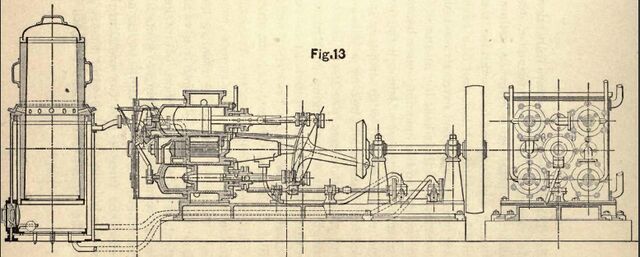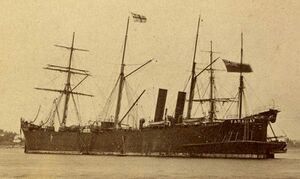كارل ڤيلهلم سيمنز
كارل ڤيلهلم سيمنز Carl Wilhelm Siemens | |
|---|---|
 كارل ڤيلهلم سيمنز | |
| وُلِدَ | 4 أبريل 1823 |
| توفي | 19 نوفمبر 1883 (aged 60) |
| القومية | ألماني |
| المهنة | Electrical engineer, businessman |
| عـُرِف بـ | عملية سيمنز-مارتن Siemens cycle Regenerative cooling Underground coal gasification |
| الزوج | Anne Gordon |
| الوالدان | Christian Ferdinand Siemens and Eleonore Deichmann |
| الأقارب | Ernst Werner von Siemens, Carl Heinrich von Siemens, Alexander Siemens |
| الجوائز | Albert Medal (1874) Bessemer Gold Medal (1875) |
كارل ڤيلهلم سيمنز (بالإنگليزية: Charles William Siemens ويعرف باسم: السير وليام سيمنز) (4 أبريل 1823 - 19 نوفمبر 1883) كان مهندساً ألمانياً.
في 1859 خصص وليام سيمنز جزءاً كبيراً من وقته للاختراعات والأبحاث الكهربائية; والعديد من أجهزة التلغراف من جميع الأنواع - كابلات التلغراف والخطوط الأرضية ومعداتها الإضافية - التي أنتجها من شركة Siemens Telegraph Works (في تشارلتون, جنوب شرق لندن) كانت حقاً مثيرة للإعجاب. في 1872 أصبح السير وليام سيمنز أول رئيس لجمعية مهندسي التلغراف التي أصبحت لاحقاً Institution of Electrical Engineers, the forerunner of the Institution of Engineering and Technology [1]
فرن سيمنز المتوالد Siemens regenerative furnace هو أعظم اختراع مفرد لكارل سيمنز, باستخدام عملية اسمها Siemens-Martin process. The electric pyrometer, which is perhaps the most elegant and original of all William Siemens's inventions, is also the link which connects his electrical with his metallurgical researches. Siemens pursued two major themes in his inventive efforts, one based upon the science of heat, the other based upon the science of electricity; and the electric thermometer was, as it were, a delicate cross-coupling which connected both. Imbued with the idea of regeneration, and seeking in nature for that thrift of power which he, as an inventor, had always aimed at, Siemens suggested a hypothesis on which the sun conserves its heat by a circulation of its fuel in space, afterwards reprinting the controversy in a volume, On the Conservation of Solar Energy.
In 1860 William Siemens constructed a remarkable gas engine (the same year the very first commercial engine was produced by Lenoir). It didn't get beyond the experimental stage, though its principle of operation (described in Siemens British patent 2074 of 1860, and by Siemens in The Theory of the Gas Engine[1]) appears to be similar to the commercially successful Brayton engine of 1872. In the discussion section of The Theory of the Gas Engine Siemens discloses that :
"The engine promised to give very good results, but about the same time he began to give his attention to the production of intense heat in furnaces, and having to make his choice between the two subjects, he selected the furnace and the metallurgic process leading out of it ; and that was why the engine had remained where it was for so long a time."
Siemens was also responsible for the hot tube ignition system used on many of the early gas engines.[2]
In June 1862 he was elected a Fellow of the Royal Society[3] and in 1871 delivered their Bakerian Lecture.
He was elected as a member to the American Philosophical Society in 1877.[4]
The regenerative furnace is the greatest single invention of Charles William Siemens, using a process known as the Siemens-Martin process. The electric pyrometer, which is perhaps the most elegant and original of all William Siemens's inventions, is also the link which connects his electrical with his metallurgical researches. Siemens pursued two major themes in his inventive efforts, one based upon the science of heat, the other based upon the science of electricity; and the electric thermometer was, as it were, a delicate cross-coupling which connected both.
In 1874 he had a special cable ship built, according to his design, for Siemens Brothers, the CS Faraday. In 1881, a Siemens AC Alternator driven by a watermill was used to power the world's first electric street lighting in the town of Godalming, United Kingdom.
انظر أيضاً
المراجع
- Shaping the Future. The Siemens Entrepreneurs 1847–2018. Ed. Siemens Historical Institute, Hamburg 2018, ISBN 9-783867-746243.
- William Pole, Life of William Siemens, (London, 1888), p. 471; Facsimile reprint Siemens Ltd. 1986, ISBN 1-85260-416-6
- Richard Hennig, Buch der berühmten Ingenieure (A book on famous engineers), (Leipzig, 1911)
- Thurston, Robert H. (1884). "Charles William Siemens". Proceedings of the Royal Society of London. 37 (49): i–x. Bibcode:1884Sci.....3...34T. doi:10.1126/science.ns-3.49.34. PMID 17736598.
- J. A. Ewing (1887). "Siemens, Sir William". Encyclopædia Britannica. 9: 22:37–38.
- Sir William Siemens – A Man of Vision, A collection of articles by various authors published by Siemens plc in 1993, contains substantial material on the history of Siemens in the UK
External links
- ^ Dugald Clerk. The Theory of the Gas Engine, D. Van Nostrand, New York, 1882
- ^ Dugald Clerk, "Gas and Oil Engines", Longman Green & Co, (7th Edition) 1897, p224
- ^ "Library and Archive Catalogue". Royal Society. Retrieved 15 October 2010.[dead link]
- ^ "APS Member History". search.amphilsoc.org. Retrieved 2021-05-10.
- Profile from the Siemens company
- Past IEE Presidents
- Portrait of Carl Wilhelm Siemens from the Lick Observatory Records Digital Archive, UC Santa Cruz Library's Digital Collections
| جمعيات مهنية وأكاديمية | ||
|---|---|---|
| سبقه John Ramsbottom |
President of the Institution of Mechanical Engineers 1872–1873 |
تبعه Sir Frederick Bramwell |
- Articles with dead external links from November 2016
- سيمنز
- مخترعون ألمان
- Burials at Kensal Green Cemetery
- أشخاص من مملكة هانوڤر
- مهندسون ألمان
- مهندسون كهربائيون
- مواليد 1823
- وفيات 1883
- تصنيع الكابلات
- 19th-century German engineers
- Bessemer Gold Medal
- British electrical engineers
- British inventors
- German industrialists
- British technology chief executives
- زملاء الجمعية الملكية
- زملاء الجمعية الملكية of Arts
- German chief executives
- German electrical engineers
- German emigrants to the United Kingdom
- 19th-century German inventors
- الحاصلون على لقب فارس
- مواطنون مجنسون في المملكة المتحدة
- People associated with the internal combustion engine
- People from Gehrden
- People from the Kingdom of Hanover
- شخصيات الثورة الصناعية
- Presidents of the Smeatonian Society of Civil Engineers
- Siemens family
- Engineers from Lower Saxony


